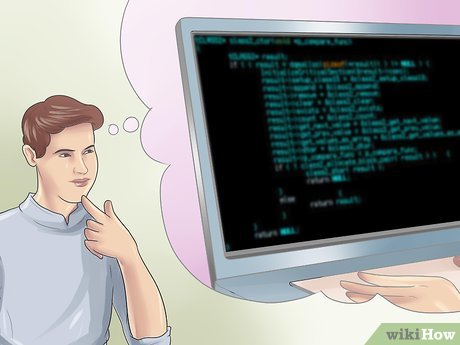How to Become a Computer Scientist
Part 1 of 4:
Starting out
-
 Become a lifelong learner. Being a computer scientist is all about learning to be a student, not just during training, but for all time throughout your career. Technology changes, new languages develop, new algorithms are devised: you need to be able to learn new things to stay current.
Become a lifelong learner. Being a computer scientist is all about learning to be a student, not just during training, but for all time throughout your career. Technology changes, new languages develop, new algorithms are devised: you need to be able to learn new things to stay current. -
 Understand your future role. As a computer scientist, it is your job to solve problems. It is also about solving problems in a way which can leave everyone happy in the end. This means learning good communication skills as well as coding skills because you are more likely to match the needs of your client with the apt solution if you listen well and relay back your understandings clearly, as well as keep the client informed during the project.
Understand your future role. As a computer scientist, it is your job to solve problems. It is also about solving problems in a way which can leave everyone happy in the end. This means learning good communication skills as well as coding skills because you are more likely to match the needs of your client with the apt solution if you listen well and relay back your understandings clearly, as well as keep the client informed during the project.
Part 2 of 4:
Writing pseudocode
-
 Start with pseudocode. Pseudocode isn't really a programming language, but it is a way to represent a program in a very English-like way. The most familiar algorithm to you is probably on your shampoo bottle: Lather, rinse, repeat. This is an algorithm. It is understandable by you (the "Computing Agent") and has a finite number of steps. Or does it ...
Start with pseudocode. Pseudocode isn't really a programming language, but it is a way to represent a program in a very English-like way. The most familiar algorithm to you is probably on your shampoo bottle: Lather, rinse, repeat. This is an algorithm. It is understandable by you (the "Computing Agent") and has a finite number of steps. Or does it ... -
 Tweak the pseudocode. The shampoo example isn't a very good algorithm for two reasons: it doesn't have a condition to end on, and it doesn't really tell you what to repeat. Repeat lathering? Or just the rinsing. A better example would be "Step 1 - Lather. Step 2 - Rinse. Step 3 - Repeat steps 1 and 2(2 or 3 times for better results) and then finish(exit)." This is understandable by you, has an end condition (a finite number of steps), and is very explicit.
Tweak the pseudocode. The shampoo example isn't a very good algorithm for two reasons: it doesn't have a condition to end on, and it doesn't really tell you what to repeat. Repeat lathering? Or just the rinsing. A better example would be "Step 1 - Lather. Step 2 - Rinse. Step 3 - Repeat steps 1 and 2(2 or 3 times for better results) and then finish(exit)." This is understandable by you, has an end condition (a finite number of steps), and is very explicit.
Part 3 of 4:
Writing algorithms
-
 Try writing algorithms for all sorts of things. For example, how to get from one building to another on campus, or how to make a casserole. Soon, you'll be seeing algorithms all over the place!
Try writing algorithms for all sorts of things. For example, how to get from one building to another on campus, or how to make a casserole. Soon, you'll be seeing algorithms all over the place! -
 After you've learned how to write algorithms, programming should come naturally to you. Buy a book, and read it entirely to learn the language. Avoid online tutorials as they're often written by hobbyists, not professionals.
After you've learned how to write algorithms, programming should come naturally to you. Buy a book, and read it entirely to learn the language. Avoid online tutorials as they're often written by hobbyists, not professionals.- However, feel free to look for help on the internet. Object-oriented languages like Java and C++ are "in" right now, but Procedural languages like C are easier to start with because they deal solely in algorithms.
-
 Programming is only the translation of pseudocode into a programming language. The more time before programming you spend planning in pseudocode, the less time you'll spend typing and scratching your head.
Programming is only the translation of pseudocode into a programming language. The more time before programming you spend planning in pseudocode, the less time you'll spend typing and scratching your head.
Part 4 of 4:
Algorithm analysis
-
 Read up on RAM (the random access machine). One of the best places to start is by reading Steven Skiena's book The algorithm design manual.
Read up on RAM (the random access machine). One of the best places to start is by reading Steven Skiena's book The algorithm design manual. -
 Learn about the limiting behavior of functions. Read up on Big O notation.
Learn about the limiting behavior of functions. Read up on Big O notation. -
 Read about how worst case inputs can break your algorithm or cost you heavily in CPU processing time. It is important to learn what ways can efficiently counteract them.
Read about how worst case inputs can break your algorithm or cost you heavily in CPU processing time. It is important to learn what ways can efficiently counteract them.
4.5 ★ | 2 Vote
You should read it
- How to Write Pseudocode
- What is pseudocode?
- Greedy Algorithm (Greedy Algorithm)
- How to Write Pseudocode
- Alignment algorithm (Merge Sort)
- 3 free tools to keep track of Google update algorithms every day
- Instagram tightens algorithms and censorship policies for racist acts
- Asymptotic analysis in Data Structures and Algorithms
May be interested
- 'Reviving' Archie - the world's first search engine
 archie, created in 1989 by computer scientist alan emtage, allows searching various 'anonymous' ftp servers around a small web of universities, researchers, governments, and the military . this is considered the first search engine in the world.
archie, created in 1989 by computer scientist alan emtage, allows searching various 'anonymous' ftp servers around a small web of universities, researchers, governments, and the military . this is considered the first search engine in the world. - Scientists have discovered a new ability of the elephant trunk
 a new study shows us how attractive the trunk is and how impressive biomechanics it is.
a new study shows us how attractive the trunk is and how impressive biomechanics it is. - The images show that this world exists incredible anomalies
 our earth hides so many wonders and mysteries that scientists have not been able to solve so far.
our earth hides so many wonders and mysteries that scientists have not been able to solve so far. - Cancer treatment with virus, a new breakthrough in medicine?
 a scientist has successfully treated her own breast cancer by injecting a specially grown series of viruses directly into the tumour.
a scientist has successfully treated her own breast cancer by injecting a specially grown series of viruses directly into the tumour. - Father of artificial intelligence (AI) - a gay science genius and a tragic life
 alan turing, the father of computer science and artificial intelligence, has lived a life full of tragedies.
alan turing, the father of computer science and artificial intelligence, has lived a life full of tragedies. - The 4000-year-old weapon, lunch box discovered in Switzerland
 the scientist discovered a piece of bow, arrow and an ancient wooden food box of a mountain climber in switzerland thousands of years ago.
the scientist discovered a piece of bow, arrow and an ancient wooden food box of a mountain climber in switzerland thousands of years ago. - How to Get an Undergraduate Research Position
 if you are interested in being a scientist, engineer, or other researcher, then experience as an undergraduate in a research laboratory can help you decide if that career path is right for you. professors are often looking for additional...
if you are interested in being a scientist, engineer, or other researcher, then experience as an undergraduate in a research laboratory can help you decide if that career path is right for you. professors are often looking for additional... - Quantum technology will make data encryption more secure
 toshiba scientist andrew hammond, working at the university of cambridge lab, believes that the current quantum key distribution systems (like magiq) will soon be replaced.
toshiba scientist andrew hammond, working at the university of cambridge lab, believes that the current quantum key distribution systems (like magiq) will soon be replaced. - Scientists were stunned when they discovered the South American frog fossils in Antarctica
 previous reports have never recorded any amphibian species on earth's southernmost continent.
previous reports have never recorded any amphibian species on earth's southernmost continent. - The golden age of antibiotics is over, the immediate future will be a nightmare for humans
 there are millions of people who die each year in an era without antibiotics, and then will be a similar number in the coming years.
there are millions of people who die each year in an era without antibiotics, and then will be a similar number in the coming years.




















 How to Become a Software Consultant
How to Become a Software Consultant How to Start a Career in Information Technology
How to Start a Career in Information Technology How to Become a Microsoft MVP
How to Become a Microsoft MVP How to Get a Job at Google
How to Get a Job at Google How to Convert Latitude and Longitude Units from Degrees to Decimal Forms
How to Convert Latitude and Longitude Units from Degrees to Decimal Forms How to Track Ships
How to Track Ships